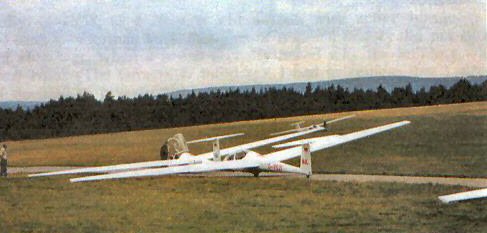WINGS OF WASSERKUPPE
A Brief history of Rhön Mountains Motorless Flight
by Glen Griffitts
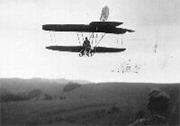
"To invent an airplane is nothing.
To build one is something.
But to fly is everything."
Otto Lilienthal (1848-1896)
Prologue
WINGS OF WASSERKUPPE
A Brief history of Rhön Mountains Motorless Flight
by Glen Griffitts

"To invent an airplane is nothing.
To build one is something.
But to fly is everything."
Otto Lilienthal (1848-1896)
Prologue
Every G. I. stationed at or who visited Wasserkuppe, Germany during the cold war era marveled at the graceful flight of gliders soaring silently overhead. A number of questions occurred to me since I served there with the USAF from 1958 to 1960. How long had gliders flown there? How did Wasserkuppe become a Mecca for sail plane enthusiasts? What is the significance of the hillside monuments? What was the original purpose of the building complex? Does the memorial hall with the sarcophagus contain the body of a glider pilot? And why is the dominant building called, "Groenhoff Haus?"Admittedly, in 1958, as a 20 year old airman with active hormones and an acquired taste for German beer, thoughts of regional history did not often cross my mind. However, when a friend recently asked why the building was called Groenhoff Haus (The Groenhoff building), I had to confess that I didn't really know. I decided to investigate and soon became drawn in by Wasserkuppe's fascinating history. The result is the following essay about the mountain, its significance to the sport of gliding, and answers to the above questions.
© 2004-Glen L. Griffitts all rights reserved
WINGS OF
WASSERKUPPE
by Glen Griffitts
According to geologists, Wasserkuppe, the highest mountain in the Rhön range at 950 meters (3,115 ft.) was created about 20 million years ago by a series of volcanic eruptions. Archeological evidence indicate settlements in the Rhön mountains date to 800 AD. Mountains along the Rhön ridge, including Wasserkuppe, were once covered by a thick forest. During the 15th and 16th centuries the age-old beech trees on the north and west slopes of Wasserkuppe were harvested for the production of charcoal. The remaining flora provided excellent pasture lands for sheep farming. The hilltops were never reforested resulting in the green picturesque open spaces seen today.The first building on Wasserkuppe was a small hut intended to shelter hunters and hikers from the harsh weather. It was constructed on June 2, 1879 by the Rhönklub, a nature hiking association. Karl Song of Poppenhausen opened the first restaurant in 1884 and operated it during the summer months. Because there were no improved roads at that time, access to the restaurant was by narrow nature trails.
In 1909 Engineer Oscar Ursinus of Frankfurt formed a team to promote the application of motorless flight. This team, mostly technical high school teenagers, studied early Otto Lilienthal theory and his bold experiments. After fabricating a glider of their own design they transported it to Rhön for trials. Oscar Ursinus became the first person to successfully test fly a glider from the cliffs of Wasserkuppe.
But the genesis of gliding actually dates to Leonardo da Vinci (1486-1513) who made notes of his studies of birds, airflow and streamlined shapes (aerodynamics). Unfortunately, after his death, his research lay dormant for nearly 400 years.
Actual heavier-than-air flight waited until the nineteenth century. Otto and Gustav Lilienthal, German engineers, began to research and experiment with flying machines near Berlin in 1881. They speculated that mastery of flight should be first demonstrated in gliders. Lilienthal's contemporaries considered such experiments foolhardy and the brothers' work was often derided. However, other scientists followed the research with great interest, including S. P. Langley, secretary of the Smithsonian Institute in Washington, D.C.
Otto built eighteen prototype airplanes over a period of five years. His first model was nothing more than wings strapped to his arms. Most of the subsequent models were primitive hang gliders that he steered by shifting his weight back and forth and from side to side. Among his failed flying machines was one with flapping wings driven by a motor. Otto finally succeeded in a gliding flight in 1892 by jumping from a small tower and launching into a light breeze. He sailed 80 feet. By reason of his documented research and experimentation, he became internationally recognized as a great theoretician of aerodynamics. The Wright brothers would later credit the Lilienthals for inspiring them to develop their powered flying machines. Lilienthal's standard glider model #11 now hangs in the Smithsonian National Air and Space Museum in Washington D.C.

Otto Lilienthal is also known for two quotes about his work, "To invent an airplane is nothing. To build one is something. But to fly is everything." The second quote was prophetic: Speaking of the hazards of flying he said, "Sacrifices must be made." Otto crashed one of his gliders on August 9, 1896 and died the following day from his injuries. Otto's brother, Gustav, then in his eighties, was in attendance when Oscar Ursinus successfully launched the first glider from Wasserkuppe in 1909.The foundation laid by Lilienthal and Ursinus was advanced by Darmstadt Technical Institute's tests at Wasserkuppe in July 22, 1912 when a new record for time aloft and distance was established by pilot Hans Gutermuth who flew the F.S.V. X. glider for one minute fifty-two seconds covering a distance of 840 meters. A replica of that plane, built by Otto Becker's team is now on display in the Glider Museum at Wasserkuppe.
Soon other technical schools began experimenting and other flying enthusiasts organized glider clubs. The early planes were often built with any light weight wood and fabric material at hand. Public interest spread as new teams worked to refine the previous designs. As a result, records for time and distance were short lived as soaring technology advanced.
The onset of World War I brought a suspension to the glider record race as national research and development became focused on Germany's war time priorities. After the war, the Treaty of Versailles placed prohibitions on building war planes in Germany. Perhaps by oversight, the treaty did not specifically prohibit the building of "motorless flying machines" and gliders soon returned to the skies above the Rhön mountains. Wasserkuppe was now recognized as being the ideal location, possessing excellent launching conditions as well as optimum air currents for soaring.
Organized by Oscar Ursinus, the first Wasserkuppe glider competition was held in 1920. Over the next decade, the contest grew in popularity. As many as 70 glider clubs sent their best planes and pilots to compete for duration, altitude and distance prizes, the most coveted prize was that donated by President von Hindenburg. As many as 60,000 spectators dotted the mountain slopes to watch these events.
On August 9, 1920, exactly 24 years after Otto Lilienthal's death, a glider piloted by Eugene von Loessl plunged from an altitude of 150 meters and crashed on the west slope of Wasserkuppe. Von Loessl, a resident of Darmstadt, was the first pilot to die on the mountain.
Several techniques were utilized to launch the gliders. A short narrow gauge trolley track was laid near the summit on which gliders could be pulled along into the wind. Others were launched by men pulling ropes fastened to the fuselage as they ran downhill into a breeze. Another method was to attach long elastic ropes to the nose. While the plane was restrained by a number of men holding onto the tail section, the ropes were stretched and attached to a fixed anchor. The hold back crew then released the plane and it was catapulted into the air. After the glider was airborne, the pilot disengaged the rope freeing him to soar with the winds. Later gliders were towed by powered aircraft and released at altitude.
A very efficient launch system involved a powered winch mounted on the bed of a truck. This method took advantage of air speed as well as natural updrafts. The truck was parked on a ridge and a 1,500 ft. cable was strung across a valley and attached to a waiting glider. When the winch became engaged, reeling in the cable at increasing speed, the glider quickly became airborne. The pilot climbed at a steep angle and at the apex, the cable was automatically released and the plane set free.
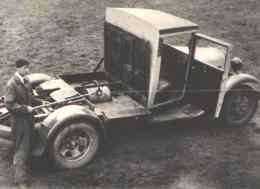
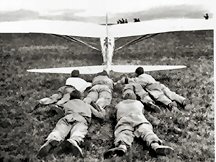
According to a New York Times article dated Aug. 22, 1922, "A glider was shoved from a precipitous cliff at Mount Wasserkuppe. The airplane, called Vampire, was immediately wafted upward 100 meters at which altitude Hentzen, a student of Hanover Technical School, hovered and cruised for several minutes before he climbed another hundred meters." Hentzen remained aloft two hours ten seconds and landed at a designated spot ten kilometers from Wasserkuppe. Many records were broken that day. Nearly all of the participating gliders were the creations of technical high school students from various parts of Germany. Despite their youth, the majority were veteran aviators of WW I. The winner of the competition received a prize of 12,000 Marks, which according to the 1922 exchange rate, equaled US $9.00 .The first American pilot to fly at Wasserkuppe was Edmund Allen, a New York socialite. Sponsored by Massachusetts Institute of Technology, he left a glider competition in Paris on August 22, 1922 for the Wasserkuppe contest to compete with the world's best glider pilots. However, his performance there was unremarkable.
Glider accidents on August 29, 1923 prompted a naive New York Times reporter to write this newspaper heading: "German Meeting of Motorless Planes a Failure". He added: "At the glider meet on Wasserkuppe in the Rhoen yesterday seven gliders crashed, destroying the high hopes held for the success of this form of flying, in which Germans had pioneered. The glider crashes were due to many new faulty constructions as well as green glider pilots."
In 1923 a memorial was erected at the Eugene von Loessl crash site. The bronze eagle and tablet mounted atop a pile of rubble stone on the western slopes of Wasserkuppe was the creation of Johannes Mossner, a Munich architect. The bronze figure, cast in Hamburg, honors von Loessl and other pioneers who lost their lives pursuing their dream of powerless flight. Such was the status of pilots of that time, the unveiling ceremony held on August 30, 1923 attracted over 30,000 spectators. Beginning in the early morning hours, the several passenger trains from Fulda to Gersfeld were filled beyond capacity. Among the attending dignitaries were: the brother of Kaiser Wilhelm II, Prince Heinrich of Prussia, Frankfurt's mayor, the widow of Baron von Richthofen (the Red Baron), various government officials and several famous generals. The program included regimental music and speeches by dignitaries followed by the unveiling of the memorial. (The public interest and attendance is remarkable considering the first improved road for motor vehicles from Gersfeld to Wasserkuppe was not completed until the following year.) Government officials proclaimed that there should be an observance at the memorial site each August 30 in honor of all fallen pilots. Indeed, annual ceremonies were held until the start of WW II.
Spectators gather for the bronze eagle monument dedication, Wasserkuppe, Germany
August 29, 1923Four years after the first glider competition was organized, Oscar Ursinus built the first clubhouse. Until then, enthusiasts were using shipping containers as temporary accommodation. Wasserkuppe had become a soaring mecca and the annual contests were international events, attracting pilots from all over Europe and the Americas.
Predicting weather conditions became very important. The collecting of weather information began in 1922 and the official weather station was established in 1925. Now called the "Ursinus Haus", the station is one of 500 such facilities across Germany providing reliable meteorological data.
The first glider school was established by Fritz Stamer in 1925. Although the national economy was racked by inflation and high unemployment, Stamer managed to eke out a living by giving flight lessons and test flying new gliders.
Virtually every European aeronautical engineer of the time tested and modified their aircraft there. Among them were Alexander Schleicher, Willy Messerschmitt, Peter Riedel and Alexander Lippisch. The 1920's saw significant achievements in design and technology, such as flying wings and even rocket powered flights.
Fritz von Opel had performed a number of publicity stunts involving rocket powered cars for his Opel motor car company. Along with Friedrich Sander, a pyrotechnics manufacturer and Max Valier, a rocketry advocate, Opel concocted a scheme to attach two rockets to an Alexander Lippisch designed tailless glider. In the summer of 1928, the three men brought the glider, called "Ente" to Wasserkuppe and hired Fritz Stammer to test it.
Two black powder rockets were attached to the skids on the underside of the fuselage. They were to be electronically fired from a switch in the cockpit. In order to adjust the center of gravity as the powder burned, a counterweight system was positioned under the floor. The rockets were timed to be fired one after the other to provide continuous thrust. Each rocket was intended to burn for about thirty seconds. After one false start, the rocket fired and the aircraft roared across the grassy field and into the air. Stammer reached an altitude of 1,500 meters (4,900 ft.), circled the mountain and landed safely.
On the second flight, the team decided to fire both rockets simultaneously thereby doubling the thrust for a 30 seconds burn. At the instant of launch, one rocket fired, but the other one appeared to sputter and as the plane left the ground, it exploded. The blast tore holes in both wings and set them on fire. Amazingly, Stammer brought the burning aircraft back to ground from an altitude of about 65 feet and quickly abandoned it. The aircraft was a total loss, as was Fritz von Opel's dream of rocket powered gliders. Stamer continued testing other glider prototypes and operated his flight school until 1933. Lippisch went on to become an accomplished aircraft designer.
Arguably, the greatest and most popular of the German glider pilots was Günther Groenhoff who set many world soaring records in distance, duration and altitude. Many of his record setting flights originated at Wasserkuppe. His first official long distance record was achieved in the summer of 1931 when he flew from Wasserkuppe to Magdeburg, a distance of 140 miles. Flying from Berlin's Templehof airport in a tailless plane he helped design, he attained a record setting speed of 90 mph. His altitude mark of 7,000 feet was set during a flight from Munich to Czechoslovakia. Not all flights were successful. During a 1931 flight from Jungfrau-Jock Mountain, high in the Swiss Alps, he lost half of his plane's rudder, but skillfully flew it to a safe landing on the valley floor 6,000 feet below.
Groenhoff further demonstrated his skill and courage while conducting research for a Munich meteorology conference in May 1931. On a mission to gather weather data, he installed various instruments on his Alexander Lippisch built "Fafnir" model 272 glider and was towed to altitude by a powered aircraft piloted by another famous pilot, Peter Reidel. As they approached towering cumulus clouds over Munich, Groenhoff's Fafnir was released to his fate. For the next eight hours, he was bounced and buffeted around the thunderstorm amid lightning flashes, hail and torrential rain, all the while collecting valuable information on weather conditions. Many times he flew in the blind. His journal indicates that he experienced one rapid descent in zero visibility to emerge from the cloud to see the ground only a few hundred feet below. He managed to bank and return to the front side of the thundercloud. He wrote, "as soon as the storm reached me, some powerful force pulled the plane straight up into the center of the clouds. It seemed to me as if I were riding an express elevator of a high skyscraper."
After soaring with the storm for eight hours, he had traveled 240 miles and finally landed on a riverbed, coming to rest a few meters short of an electric line near Kaaden, Czechoslovakia. Groenhoff wrote that he was gratified that he was able to bring home "the rich material for meteorological research."
Back at Wasserkuppe on July 23, 1932, Groenhoff once again soared into the strong, turbulent winds of a thunderstorm. However, his good fortune had run out. The rudder of his beloved Fafnir snapped and he crashed on the west slope, dying instantly. He was 23 years old.
As the National Socialist Party came to power in the 1930s, the glider school and talented young fliers drew the attention of the Nazis who saw an opportunity to utilize the planes, pilots and launching facilities at Wasserkuppe. In 1933 the old Rhön-Rositten Club (a branch of the Hesse Flying Club) was dissolved and the it's officers dismissed. The organization re-emerged as the "German Air Sport Union" headed by Dr. Oscar Ursinus as part of the Nazi system. All gliding activities, including research and development, became controlled by the state.
As Germany made further preparations for an inevitable war, Wasserkuppe became an official training camp for the Nazi Youth Flight Corps. Exploiting a loop hole in the Treaty of Versailles, Hitler did everything possible to encourage glider flying. Funding for the program was subsidized through the efforts of brown-shirted storm troopers who "urged" German citizens to donate to "sport flying". It would be an easy matter to transform the skilled, young glider aviators into fighter and bomber pilots. Many of the technical school pilots had built their own planes. They represented a body of trained men who would be able to take leadership roles in airplane factories in time of conflict.
Larger permanent buildings were required to meet the increasing demands of the Third Reich. A headquarters building, barracks and support facilities were erected east of the summit. Upon completion, the opening ceremony was held during the annual glider competition on August 27, 1936, exactly seven years after Groenhoff's death. Among the leading dignitaries at the ceremony was Luftwaffe Lieutenant Colonel Mahnke. Following the obligatory Nazi speeches, the headquarters building was christened "Groenhoff Haus". The barracks, in the west wing, was later named "Ring Haus".
The "Ehrenhalle" (Hall of Honor) was designed with a large stained glass window and built directly the across the compound from the headquarters building. Large bronze doors open to the interior of the hallowed hall. A marble sculpture of a pilot dressed in a flight suit is lying atop a sarcophagus. Although no one is actually buried there, the figure is the likeness of aviation pioneer Otto Lilienthal and intended to represent all pilots who lost their lives in glider and powered flight. This building was christened "Lilienthal Haus" on July 23, 1939.
By this time, the Wasserkuppe Nazi Youth Flight Corps was operating at full capacity. Luftwaffe personnel on site numbered over 40 instructors and support personnel. During a 1943 allied air assault, Wasserkuppe suffered the loss of twenty men killed and numerous casualties. All Nazi aircraft, glider hangers and the flight operations center were destroyed.
Following the war, the Groenhoff Haus complex was occupied by US Forces. A long range radar station and surveillance facilities were established on the summit of Wasserkuppe. During the Berlin Airlift of 1948 -1949, the radar station supported "Gunpost", the air traffic control site responsible for the southern air corridor from Frankfurt to Berlin. This Wasserkuppe tech site provided navigation aid for the transport aircraft. On June 10, 1949 the radar station became attached to the 601st Aircraft Control and Warning Squadron, headquartered at Rothwesten, near Kassel.
On August 4, 1950 the German Air Club was re-established in Gersfeld. Herr Wolf Hirth was elected president and Fritz Stamer (noted test pilot of the rocket powered glider) was named general secretary. Soon after the restrictions on German aviation were lifted in 1951, gliders were once again seen flying above the mountain.
A new glider school was opened in 1953. The annual international glider competition resumed in the mid 1950's. Once again, tourists began to visit the mountain to enjoy the clean fresh air, spectacular vistas and the graceful flights of the gliders. New tourist facilities appeared on the mountain and tour buses became a common sight, especially on summer weekends. In 1959 a new record was set when Günter Heinzel, Director of the Wasserkuppe Gliding School and former Luftwaffe test pilot, flew a glider from there to Paris in eight and a half hours.
The USAF radar facility was expanded during the height of the cold war and weather proof radar domes were constructed at the summit. The new German Air Force began training there and assumed some of the air traffic control responsibilities. After the fall of the Berlin wall and re-unification of the two Germanys, the USAF radar facilities at Wasserkuppe were deactivated and the complex was turned over to civilian authority.
Located near the former front gate of the Groenhoff Haus complex, a glider museum opened in 1970. Astronaut Neil Armstrong was an honored guest at the dedication. The museum moved into the present building in 1987. The mountain also became home to the Old timer Gliding Club, an association of glider fans dedicated to the preservation of vintage aircraft.
A new generation of aviators have emerged. Hang gliders and parasails have had a significant impact on the contemporary glider scene as Rhön's summer skies have become dappled with brightly colored sails. Sadly, at least for me, the new breed of fliers are now outnumbering traditional glider pilots. With the help of the German Glider Museum and the Old Timer Glider Club, one can hope that future generations will appreciate the courageous contributions and sacrifices made by Wasserkuppe's pioneers of motorless flight.
EPILOGUE
Fafnir~ a dragon of Norse mythologyEngineer Dr. Alexander W. Lippisch, (1892-1976) Designed the Ente (Duck) tailless glider that was retrofitted for the rocket powered flight in 1928. His Fafnir glider was actually built on Wasserkuppe in 1930. The cockpit was customized for Groenhoff who was small in stature. During WW II, Lippisch went on to design a liquid fuel rocket- powered fighter interceptor, the Messerschmitt Me-163 Komet. In January 1946 Lippisch was brought to The United States as a part of Operation Paper Clip, a War Department program. He subsequently designed the first delta wing jet fighter, the F-102 Delta Dagger. He was credited with inventing the hydrofoil boat, among his many accomplishments. Dr. Lippisch died in Cedar Rapids, Iowa 11 February 1976.
*************************************************************
The New York Times archives, Gersfeld, Fulda and Rhön regional newspapers, various periodicals and Internet web sites were the primary sources for this article.
I wish to acknowledge Otto Becker of Poppenhausen, Germany, a member of the Old Timer Sail Plane Cub Wasserkuppe and the German Glider Museum Wasserkuppe for his generous contribution of historical data and assistance with German-English translation.
~G.G.© 2004-Glen L. Griffitts all rights reserved
Gunpost@aol.com

Glider launch the hard way

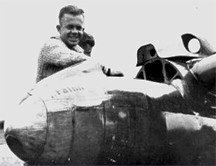
Champion glider pilot Guenther
Groenhoff
and his "Fafnir". circa 1932
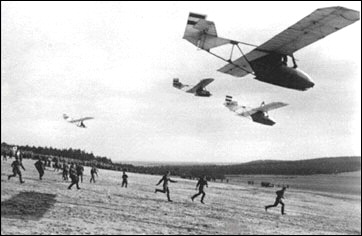
Mass launch of training gliders at
Wasserkuppe
circa 1936
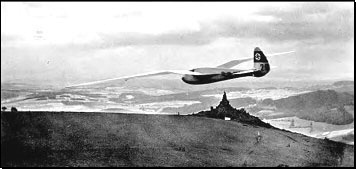
Nazi glider soars over the bronze eagle monument at
Wasserkuppe
Circa 1938
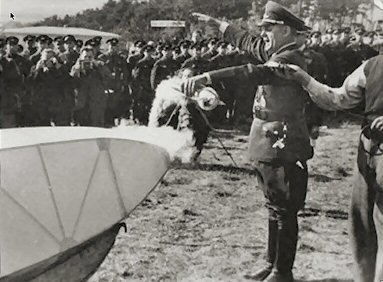
Luftwaffe officer christens a
glider
circa 1938
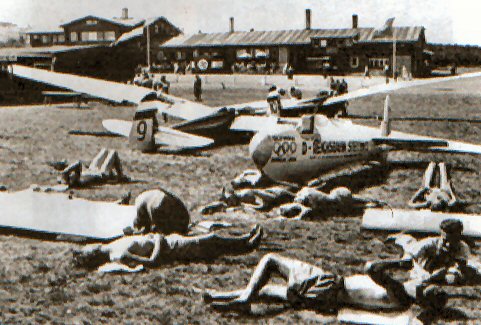
Wasserkuppe
circa 1936
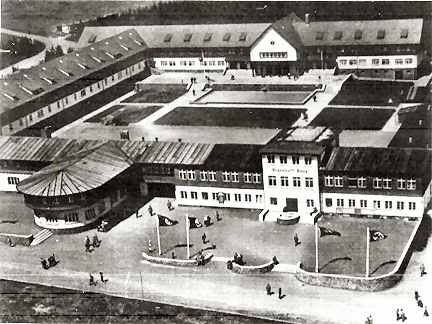
New "Groenhoff-Haus" training facility for the Nazi
Youth
Flight Corps, Wasserkuppe 1938

Pilots memorial in Lilienthal wing of Groenhoff Haus
Wasserkuppe

Glen Griffitts and USAF colleague J. E. Klutts
during
visit to Wasserkuppe in 2000
